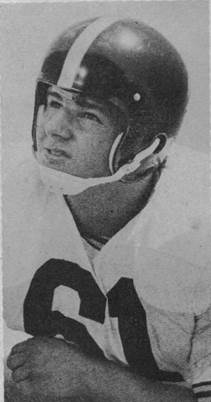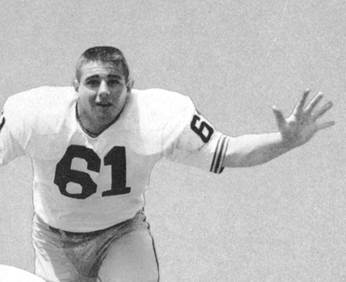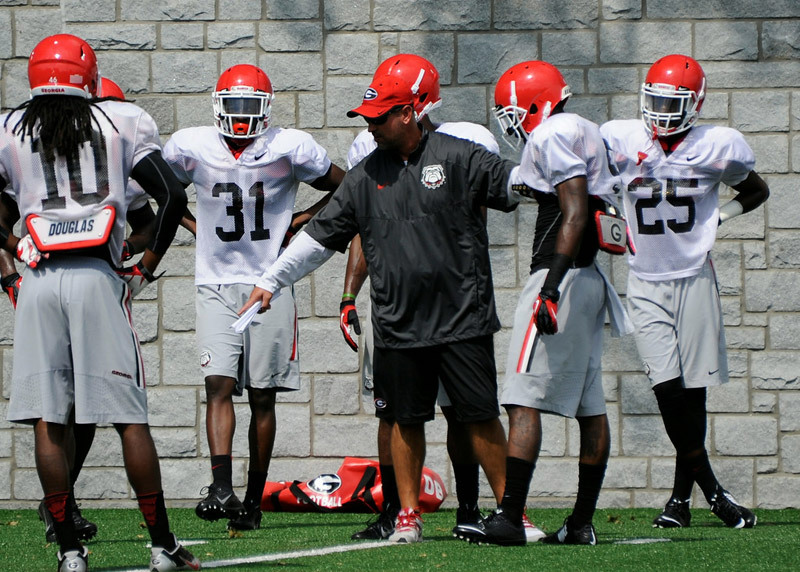

THEY USED TO CALL IT FOOTBALL, PART THREE
HELMET HUT NEWS/REFLECTIONS November 2015:
THEY USED TO CALL IT FOOTBALL, PART T
HREE
By Dr. Ken
One can run, do specific football related drills, lift weights, and even include contact against a hand held bag or sled in order to prepare for their upcoming football season. One of the great truths of football that is learned as early as high school and which becomes emphasized at the collegiate level, is that you can be in great “condition” but you cannot be conditioned to block and tackle until you block and tackle. The only way to become conditioned to the contact is to hit and be hit, to be exposed to actual contact. Before the start of sixth grade I became aware that there was a core group of athletes in our area that spent summer evenings running, throwing a football, and doing what appeared to be specific football type of drills during the evenings. They would meet three or four times each week on the beach or at the high school field and work hard for approximately ninety minutes or until the darkness made it difficult and a bit hazardous to continue. The group varied from eight to eighteen or more on any evening and some remained a part of that group of trainees for a number of years. They had attended different high schools with some playing at large college programs, some at smaller ones and others at what were still nationally respected Ivy League programs. A few would bring teammates to the sessions, these “outsiders” presumably visiting for a short time but who enthusiastically jumped into the mix of sprinting up and down sand dunes, running in knee or waist-deep ocean water, doing “fireman’s carry” in the soft sand, and a few years later, when our younger group became incorporated into the main group, a drill we referred to as “Hamburger” which was no more than the standard Oklahoma Drill done without protective equipment.
All of us lifted weights when it
was still a shunned or
negatively interpreted activity,
and all of us were strong
relative to bodyweight and
certainly presented at our high
school, college, or pro camps in
superior physical condition when
compared to most of our
teammates. Yet, every one of us,
when we first saw or spoke to
each other after the
commencement of fall camp, would
comment that our level of
soreness after the hitting
began, was equivalent to that of
our teammates. We could run
further and drill longer than
anyone, we were strong, and by
every measure we were
“well-conditioned,” but when the
contact came, we suffered the
same two or three days of
extreme soreness from the actual
contact. It was a harsh reminder
that you needed to be hit in
order to be conditioned to be
hit! It really was that simple.
HISTORICAL INSERT: Lou
DeFilippo, Jr.
 |
Lou “Babe” DeFilippo, Jr. Purdue’s 1962 Big Ten Sophomore Of The Year
For many years the number
of Division 1 football
players recruited from New
York State has been
constant, averaging a bit
less than twenty-five per
season. In years that
Syracuse has been more
successful in their in-state
recruiting, the overall
number increases but most
college coaches will quickly
state that they place their
focus onto the northern New
Jersey area long before they
venture into New York State.
Of those approximately
twenty-five scholarship
players, three to six will
hail from Long Island. This
number too has been constant
with the involved
universities varying,
dependent upon which
assistant college coaches
have connections in the
region. Legendary Amityville
High School coach Lou Howard
produced powerhouse teams
throughout the 1950’s and
‘60’s, featuring great
players like Bernie Wyatt
and John Niland who both
attended Iowa. Predictably,
both were outstanding
players at Iowa. Niland was
later an All Pro offensive
lineman with the Dallas
Cowboys while Wyatt became a
long time assistant coach at
his alma mater and then at
Wisconsin under Barry
Alvarez. When Wyatt was a
position coach and
recruiting coordinator at
both schools, they had
numerous Long Island and New
York/New Jersey Metropolitan
players on those squads due
to Bernie’s many contacts in
the area. Purdue University
too regularly recruited a
number of Long Island
players between 1960 through
the mid-1970’s. Unlike some
of the players recruited to
Iowa by Wyatt who later
became “name players” like
Niland or twelve-year NFL
veteran and first round
draft choice Ronnie Harmon,
Purdue focused on solid
players who for the most
part, became integral parts
and multi-year letter
winners of what were
terrific offensive lines.
Sal Ciampi who has been
mentioned in numerous HELMET
NEWS/REFLECTIONS articles
has been perhaps the best
known locally, receiving
national recognition as a
record setting high school
coach following his
outstanding Purdue career
that included being the
third Boilermaker to be
named as an Academic All
American, and as an All Big
Ten selection who captained
his squad and then had an
outstanding Blue-Gray Game.
 |
At only 5’9” and 201 pounds, few hit as hard and consistently as Salvatore Ciampi of Lawrence High School. Sal was a workout warrior, often setting the pace in the local garage where a number of collegiate and high school players gathered to lift weights over the summer. Here he leads Purdue back Gordon Teter against Notre Dame. Sal is revered as one of Long Island’s greatest high school players and coaches
Though more
standouts like Gary
and Henry Feil would
follow and well
represent the
Boilermaker
offensive lines, a
contemporary of
Sal’s perhaps had
the most potential
to be an all-time
great. Lou DeFilippo
Jr. of W. Tresper
Clarke High School
certainly had an
example to follow,
one that lived in
his own house. His
father, Lou
DeFilippo had been
the leader of his
Hillhouse
(Connecticut) High
School team that won
the state
championship, a
center on the very
good Fordham teams
of the 1930’s, and a
member of the N.Y.
Giants in 1941 and
following his
military commitment,
again from 1945
through ’47. He
later coached with
the Baltimore Colts
and at Fordham and
Columbia
Universities. A
teacher at heart, he
followed his college
and pro work with a
life of high school
teaching and
coaching, first at
Long Island’s Clarke
High School and then
as head coach at
East Meadow where
from 1961 through
’67 he compiled a
46-9-1 record that
included a number of
championships. He
made his lasting
mark returning to
Connecticut to coach
Derby High School
from 1968 through
1982, going
116-30-8, having
five undefeated
teams, and winning
state championships.
This revered molder
of men spent part of
his World War II
military service
time playing
football at Purdue
University and this
is where he steered
son Lou Jr. who had
his choice of
numerous colleges.
“Babe” as younger
Lou was often
referred to, was a
5’9”, 235 pound
block of muscle who
also spent the Long
Island summers
running and lifting
and it paid off his
sophomore season of
1962 when he was the
Big Ten Sophomore Of
The Year and named
to a number of All
American teams at
tackle.
With more stardom
forecast, he was
derailed for the ’63
season after a May
25, 1963 auto
accident that
resulted in a severe
injury to his left
arm, costing him a
redshirt season. He
returned and started
for the Boilermakers
at left tackle for
the 1964 and 1965
seasons on the
opposite side of the
line of Ciampi, his
high school rival.
Like Sal and his
father, Lou Jr.
became a highly
respected and much
beloved high school
teacher and coach
before passing away
at a relatively
young age. The work
put in over the
summers accurately
predicted the
success that came
once the season
started for Lou and
a dedicated group of
Long Island athletes
from a past era.

As a logical
thinker, the formula
for today’s game of
football and its
appalling lack of
fundamentals related
to blocking and
tackling is a rather
easy one:
Lack of time dedicated
to football related
activity due to NCAA
limitations +
Lack of allowed contact
during every aspect of
NFL related activity as
mandated by the
Collective Bargaining
Agreement =
Lack of proper blocking and tackling ability and techniques.
I only wish that my physics classes had been this simple! I would like to repeat that hard core football fans and especially Fantasy Football Fans (please allow me to more accurately describe that as “Gambling Football Fans” who may know statistics but don’t necessarily know “football”) marvel at the “skill,” size, speed, and athletic ability of today’s player but coaches at every level complain that the game has changed, not because it is “softer” but because there is such a dearth of fundamental teaching and learning. The reminders are everywhere. While watching a segment of Inside The NFL, commentator Phil Simms, in what had to be no more than a short paragraph of verbiage had it been in written form, made at least three references to a defender on screen, making “a form tackle.” This so-called form tackle, to anyone who played the game in the 1950’s through the mid-1970’s, was no more than “a tackle,” what used to be a “regular,” run of the mill, every play, put-your shoulder-on-the-ball or between the numbers, wrap up, and drive tackle. This was truly a “no big deal” tackle, yet Simms’ ongoing, gushing description made one immediately realize that this truly was a “form tackle,” one made in accordance with proper technique where the player broke down into a tackling stance, made contact, wrapped his arms around the ball carrier, and drove his opponent to the ground. It is now indeed a big deal, as routine as it would have been in a previous era, simply because no one does it any longer or at least it is no longer done with frequency.

Respected football writer Bucky Brooks, a former NFL player, noted soon after the passage of the NFL CBA, all of the predictions that have become reality. On August 10, 2011, Brooks wrote,
“Gone are the
grueling two-a-day
practices that have long
been a staple of
training camps. In their
place, teams are able to
conduct one full-contact
padded practice per day
accompanied by a
walkthrough period. The
league has also placed
limits on the number of
full-contact padded
practices during the
regular season. Teams
are permitted a total of
14 for the year with 11
of those practices
conducted during the
first 11 weeks of the
season (a maximum of one
per week)… The loss of
full-contact practices
could rob them (teams
built upon physical
aggressiveness) of the
edginess that allows
them to bully
opponents.”
What passes for “typical
practice attire” in today’s
game of football
Most telling was his
statement that now
clearly echoes what NFL
coaches especially are
lamenting; “They assert
the lack of contact will
leave their squads
unprepared for the
intensity and
physicality of the
game.” I can only say
“Absolutely.” The
predictions for
deterioration in contact
related skills were
obvious. Brooks, Mark
Maske, and others spent
time writing and talking
about this:
One of the important
statistics that needs to
be discovered is the
comparison of head and
neck injuries relative
to knee and lower
extremity injuries.
Maintaining a focus on
protecting the head and
cervical spine is
certainly positive but
if a defender defines
the lower body and
especially the knee area
as “a safer hit” that
will not get them
ejected or earn a
fifteen yard penalty,
then what? The fact is
that defenders have,
since the inclusion of
the most recent CBA
enforced rules,
complained that “there
is no safe place to hit
an offensive player.”
They are penalized and
criticized for hitting
high and risking or
incurring an opponent’s
head injury, and
penalized and criticized
for hitting low, viewed
as “trying to take his
knee out.” An injury
comparison relative to
pre-CBA days could be
revealing.
The bottom line is this,
in my limited opinion:
the game is sloppy, not
well played, and
certainly not “the
physical ballet”
performed by masterful
athletes that the NFL
Network and ESPN would
have the public believe;
it is not yet proven to
be safer relative to
long term injury
compared to the “old
rules” days; the lack of
time and absence of
practice contact has
produced poorly executed
techniques or a lack of
proper and safe
techniques in blocking
and tackling that
perhaps have led to an
increased rate and/or
severity of injury. It
is not certain that the
National Football League
or NCAA would provide an
honest statistical
analysis in either case
as they seem content to
live off of the
marketing emphasis of
the “big hit” and public
perception that they
have produced a safer
game.
